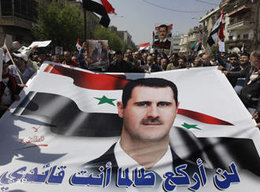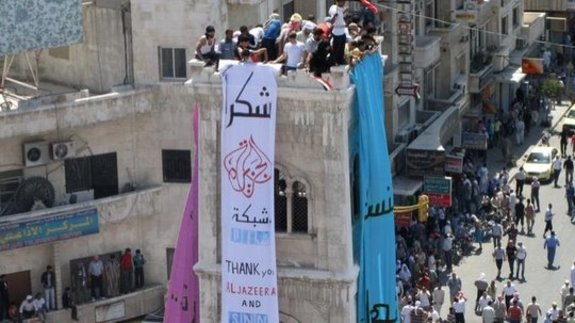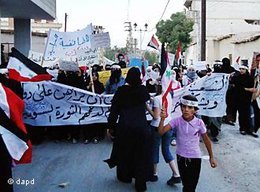Iron Hand and Bloody Reform
A feeling of apprehension rather than calm has been the defining emotion in downtown Damascus for months now. Though superficially life here may seem to be following something like its normal course, a closer look reveals tensions of a kind unfamiliar to the citizens of the Syrian capital, bubbling just below the surface.
A cautious, wait-and-see character is ingrained in the people of Damascus. It is a trait they have developed over the centuries and one that has allowed them to survive through all the violent revolutions that have swept the country. But with the security situation now so completely out of control, optimism and resilience seem like qualities consigned to the past.
The protests have already reached several districts of Damascus. Midan and Rukn ad-Din have seen demonstrations and there were particularly large turnouts in some of the suburbs and outlying areas of the city such as Duma, Darayya, Al Moadamyeh, Barzeh, Qabun, Al-Kiswa and Saqba. News from other cities, villages and regions in Syria where most of the peaceful protests have taken place, has led to a feeling in the capital that it is their silence that has been the price paid for the current stability of the country.

There are currently two competing camps in Damascus. One is not permitted to demonstrate, the other is not only allowed to do so, it is positively urged into it. Regime supporters crowd the streets and squares, singing and chanting, waving national flags and pictures of Assad. They are granted the privilege of speaking for the Syrian regime, the Syrian media are always present, and the police even stop traffic to accommodate them.
Regime's rent-a-mob
Millions purportedly demonstrate under supervision of the security forces – among them supporters of the bloc parties, officials and employees from state authorities and state-owned companies, workers from private businesses whose owners are connected to the regime, and the children of army officers, government officials and members of the intelligence services.
There are some who take part in the demonstrations from conviction, while others are pressurised, compelled or offered enticements to do so. That's the way it is in the daytime. After dark, the same people take to their cars and drive through some of the residential areas of Damascus, honking their horns and chanting slogans until late in the night, sometimes until dawn. The convoys are made up of luxury limousines and hired cars, with young men and women in colourful apparel leaning out of their windows waving as if intent on intimidating anyone foolhardy enough to be asleep or not participating in the demonstration.
This kind of discrimination was unknown until the Baath Party came to power. Since their takeover in the coup of 1963, the Syrian streets have been exclusively reserved for demonstrations by workers, farmers and students – no matter whether they are demonstrating voluntarily or not.
If you look at the modern history of Syria, whether during the Ottoman rule, under the French, after the country gained its independence or during the subsequent phase of the so-called Damascus coups, it was always in the city that most demonstrations took place.
During the Ottoman and French periods demonstrations would begin in the old town at the Maktab Anbar, go through the residential areas and the market district to Qaimariye, by way of Naufara, Qabaqibiye and Qawafin and the Souk al-Hamidiyeh to the Saraya Palace, and on to Marje Square or the French administration headquarters in Salihiye.
Demonstrations and "flying protests"
Following independence and during the period of the military coups that preceded the rise of the Baathist regime, marches began at the university or the Tajhiz School and ended at the parliament. During the conflict between the Baathists and the Nasserists, marchers were often surrounded to prevent them from getting started. On one occasion at the Tajhiz School, police surrounded the building and called in an army unit with trucks and armoured cars for support.
The soldiers took command of the situation, lying on the ground with their guns trained on the school windows. The pupils, meanwhile, took to the roof of the school building armed with stones with which they proceeded to pelt the army.

Several soldiers were injured in the exchange and eventually, after the headmaster had negotiated with the army, it was agreed that the pupils should be allowed to go home, fatalities having been avoided. Though there were a few arrested, they were released a few hours later. Was this just a case of army negligence at the time, or were the security forces lacking the necessary experience in suppression?
During the current crisis, it has not always been possible for the security apparatus, the army or the Shabbiha militia and their supporters, loyal to the regime, to stop the demonstrations in parts of Damascus. These recent protests have been much more spontaneous than the kind that took place here in the past. The demonstrations in Salihiye Street, Al-Hamra Street, in Qanawat, at the University or the Faculty of Economics were "flying protests".
Interrogation, torture and forced confessions
A few dozen unarmed people demand freedom, and if they move down the street they very quickly find themselves confronted by armed men who are ready to beat them back with sticks and clubs, which they brandish with fervent hatred. And when ambulances arrive they disgorge even more weapon-carrying hired heavies who round up passers-by, forcing them into the ambulances where they continue the beatings until they arrive at the headquarters of the state security service. Once there, they will be subjected to interrogation and torture and forced into confessions.

There are no trouble-free Fridays in Syria anymore. Yet this was traditionally a day when the people of Damascus undertook leisurely excursions. In the early days of the last century, before concrete blighted the landscape, one would take a hookah, pack some tasty snacks and fruit and go down to the Ghouta Gardens close to the city or take a trip to the gardens at Salihiye, Rabwe or Dummar. One might sit on the banks of the Barada, in Shadarwan or in Safwaniyah Park.
Nowadays, the younger generation of Damascene, as well as those who have moved to the city, have swapped the tradition of fun trips to the outskirts for a new pastime of Friday demonstrations with the locals in Duma, Harasta or Darayya. They are not doing this because they believe it to be a safe way of demonstrating – quite the contrary. Clubs may be used against them in the city; but here they run the risk of being shot.
Bloody solutions are no solutions
This, then, is the way it works, this new statutory right to demonstrate, a right that is actually a ban on demonstrations. These are the reforms that the regime is offering in the name of freedom of expression. Actually, every reform measure so far announced has been followed by a doubling up of violence that has deprived the reform of any significance. It is a reminder that the iron hand of the regime squeezes the life out of any reform at birth. Bloody as the reforms are, they simply represent a means of allowing the regime to apply the most brutal violence.
If the regime really wants reform – and who knows whether there is still time enough to achieve this – then it will have to make sacrifices. It will have to sacrifice its security apparatus, which remains the strongest and most powerful obstacle to reform. Rather than protecting the people from enemies it has been instrumental in their suffering. The people have been oppressed by it and robbed of their dignity.
The speedy introduction of earnest and significant reforms would be a sign of the regime's strength. But this would also represent a painful concession by a state that has always believed itself in the right and, accountable to no one, been able disregard all criticism and ignore advice.
Simply continuing to suppress protest by the application of more and greater violence will not automatically end the protest, and defeating their own people can never justify the regime. Bloody solutions are no solutions at all, and the government's use of violence is merely self deception. Intransigence cannot ever be a way of dealing with reasonable and justified demands. Even if a solution that included the security forces were to be opted for, there can be no excuse for excess.
For months now in Syria we have been hearing that there is no going back. Today, this can only be interpreted as meaning that the regime has no intention of changing course; it will continue to crush the protests and the protesters will go on protesting. When this all began there was a great deal of fear, but also much hope. The optimism is now being drowned in blood.
Fawwaz Haddad
© Qantara.de 2011
Fawwaz Haddad published his first novel "Mosaic, Damascus '39" in 1991. Since then he has written several more, including "A Fleeting Scene", "The Unfaithful Translator", "A Solo Performance on Piano" and "God's Soldiers". "The Unfaithful Translator" was nominated for the 2009 Arab Booker Prize.
Editorsd: Arian Fariborz, Lewis Gropp/Qantara.de
